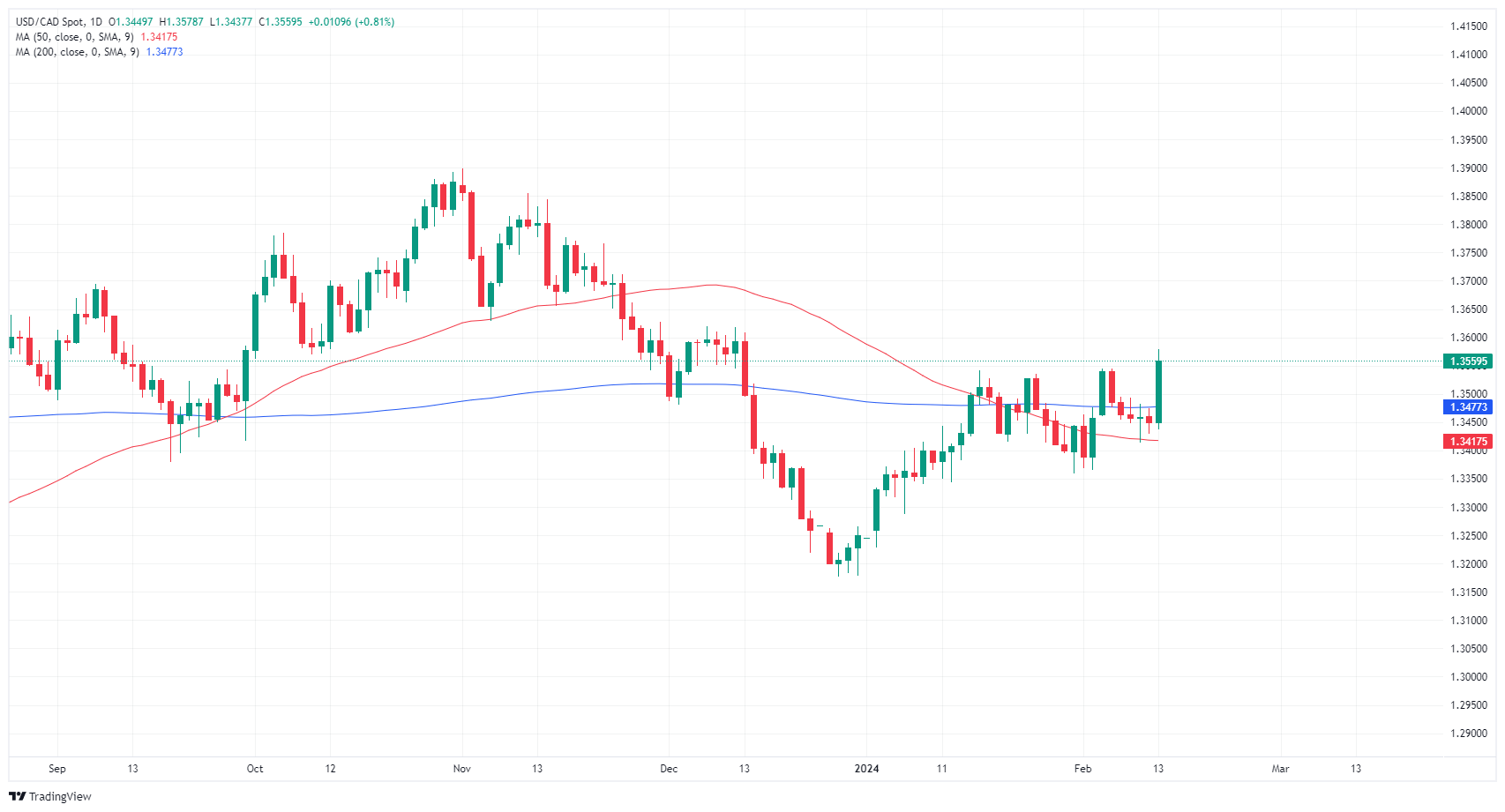- Markets were surprised on Tuesday by the unexpected persistence of US CPI inflation.
- In Canada, this week's economic agenda lacks representation.
- The Canadian dollar is trading mixed, but falls sharply against the US dollar.
The Canadian Dollar (CAD) fell against the US Dollar (USD) on Tuesday, after US Consumer Price Index (CPI) inflation rose on a monthly basis, leading to a rally in the Dollar across major currencies. . Annual inflation was also higher than consensus in January, dashing market hopes for a May rate cut by the Federal Reserve (Fed).
This week's Canadian economic agenda is limited to publications of little relevance. Data on housing construction in Canada and manufacturing sales will be published on Thursday, and foreign investment figures on Friday. January home construction starts in Canada are expected to rise slightly, but US retail sales will completely eclipse the release.
Daily Market Moves Summary: Canadian Dollar Takes a Backseat as Markets Focus on US CPI Inflation
- US headline month-on-month CPI inflation rose to 0.3% in January, compared to the expected 0.2%.
- The December CPI suffered a slight revision from 0.3% to 0.2%.
- Annualized US CPI core inflation remained at 3.9%, compared to the expected 3.7%.
- The US year-on-year CPI fell to 3.1% from 3.4%, but markets expected a further slowdown to 2.9%.
- Persistent US CPI inflation pushes markets away from bets on a first Fed rate cut until June or July.
- Money Markets now see a 62% chance of no rate cut in May, according to CME's FedWatch tool.
- The US Dollar is rising on the day as markets once again bet on the safe haven Dollar.
- On Wednesday, Fed officials such as Goolsbee and Barr will discuss the issue.
- US Retail Sales will be released on Thursday, with markets expecting a figure of -0.1% for January, down from 0.6% in December.
- The Consumer Price Index (PPI) and the Michigan Consumer Sentiment Index will be released on Friday.
Quote of the Canadian Dollar today
Below is the percentage change of the Canadian Dollar (CAD) against the currencies listed today. The Canadian dollar was the strongest currency against the Swiss franc.
| USD | EUR | GBP | CAD | AUD | JPY | NZD | CHF | |
| USD | 0.52% | 0.22% | 0.81% | 1.08% | 0.89% | 1.12% | 1.28% | |
| EUR | -0.53% | -0.30% | 0.29% | 0.56% | 0.38% | 0.60% | 0.75% | |
| GBP | -0.21% | 0.31% | 0.60% | 0.87% | 0.69% | 0.92% | 1.07% | |
| CAD | -0.82% | -0.29% | -0.59% | 0.25% | 0.09% | 0.31% | 0.48% | |
| AUD | -1.11% | -0.57% | -0.88% | -0.27% | -0.19% | 0.05% | 0.23% | |
| JPY | -0.90% | -0.37% | -0.68% | -0.09% | 0.18% | 0.22% | 0.39% | |
| NZD | -1.14% | -0.62% | -0.91% | -0.33% | -0.05% | -0.23% | 0.16% | |
| CHF | -1.28% | -0.76% | -1.06% | -0.46% | -0.22% | -0.38% | -0.15% |
The heat map shows the percentage changes of the major currencies against each other. The base currency is chosen in the left column, while the quote currency is chosen in the top row. For example, if you choose the euro in the left column and scroll down the horizontal line to the Japanese yen, the percentage change in the box will represent EUR (base)/JPY (quote).
Technical Analysis: Canadian Dollar Gives Ground Against US Dollar, But Trade Mixed Overall
The Canadian dollar (CAD) gave up around three-quarters of a percentage point against the US dollar on Tuesday, and also lost around half a percentage point against the British pound (GBP). The CAD recovered half a percentage point against the Swiss Franc (CHF) and around a third against the New Zealand Dollar (NZD).
On Tuesday, the USD/CAD pair hit eight-week highs at 1.3578. The pair rose more than a percentage point from bottom to top on the day, easily reclaiming the 1.3500 area.
Tuesday's bullish breakout in USD/CAD has the pair breaking above the 200-day SMA near 1.3477, and the trick for buyers will be to prevent the pair from falling back into a consolidation range. below 1.3550. On the lower end, the 50-day SMA near 1.3417 will provide a short-term technical floor.
USD/CAD hourly chart
USD/CAD daily chart
Frequently asked questions about the Fed
What does the Federal Reserve do and how does it affect the dollar?
The monetary policy of the United States is directed by the Federal Reserve (Fed). The Fed has two mandates: achieving price stability and promoting full employment. Your main tool to achieve these objectives is to adjust interest rates.
When prices rise too quickly and inflation exceeds the Federal Reserve's 2% target, it raises interest rates, raising borrowing costs throughout the economy. This translates into a strengthening of the US Dollar (USD), as it makes the United States a more attractive place for international investors to place their money.
When inflation falls below 2% or the unemployment rate is too high, the Federal Reserve can lower interest rates to encourage borrowing, which weighs on the greenback.
How often does the Federal Reserve hold monetary policy meetings?
The Federal Reserve (Fed) holds eight meetings a year, in which the Federal Open Market Committee (FOMC) evaluates the economic situation and makes monetary policy decisions.
The FOMC is made up of twelve Federal Reserve officials: the seven members of the Board of Governors, the president of the Federal Reserve Bank of New York, and four of the eleven presidents of the regional Reserve banks, who serve for one year on a rotating basis.
What is Quantitative Easing (QE) and how does it affect the USD?
In extreme situations, the Federal Reserve can resort to a policy called Quantitative Easing (QE). QE is the process by which the Fed substantially increases the flow of credit into a clogged financial system.
It is a non-standard policy measure used during crises or when inflation is extremely low. It was the Fed's weapon of choice during the Great Financial Crisis of 2008. It involves the Fed printing more dollars and using them to buy high-quality bonds from financial institutions. QE usually weakens the US dollar.
What is Quantitative Tightening (QT) and how does it affect the US Dollar?
Quantitative tightening (QT) is the reverse process of QE, whereby the Federal Reserve stops buying bonds from financial institutions and does not reinvest the capital of the maturing bonds it has in its portfolio to buy new bonds. It is usually positive for the value of the US Dollar.
Source: Fx Street
I am Joshua Winder, a senior-level journalist and editor at World Stock Market. I specialize in covering news related to the stock market and economic trends. With more than 8 years of experience in this field, I have become an expert in financial reporting.







